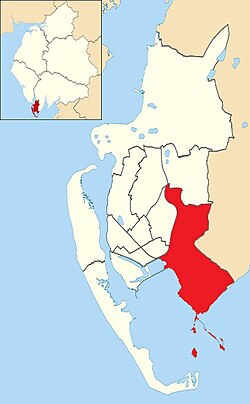Roose
| Roose | |
|---|---|
 Roosecote Power Station is located in Roose directly adjacent to Rampside Gas Terminal  Roose shown within Barrow-in-Furness |
|
| Population | 4,724 (2011 Ward) |
| District | |
| Shire county | |
| Region | |
| Country | England |
| Sovereign state | United Kingdom |
| Post town | BARROW-IN-FURNESS |
| Postcode district | LA |
| Dialling code | 01229 |
| Police | Cumbria |
| Fire | Cumbria |
| Ambulance | North West |
| EU Parliament | North West England |
| UK Parliament | |
Roose or Roosecote is a suburb and ward of Barrow-in-Furness, Cumbria, England. The word 'roose' is Celtic for "moor" or "heath" and the suffix 'cote' of Roosecote means "hut" or "huts" (the word 'cottage' is derived from 'cote'). Before the building of Roose Cottages and the arrival of the Cornish miners Roose was pronounced with a hard S, as in goose; now it is locally pronounced 'Rooze', due to the Cornish accent. Roose is served by Roose railway station, one of the few remaining stations on the Furness Line in the Barrow area.
The ward of Roose also encompass the settlements of Rampside and Stank, as well as Piel Island and Roa Island, it extends as far north as Abbot's Wood Nature Reserve.
Roose has been in existence since at least 945 AD. Roose is mentioned in the Domesday Book as one of the townships forming the Manor of Hougun which was held by Tostig Godwinson, Earl of Northumbria. Roosecote and Roose were originally two separate entities. Roosecote was founded by Michael le Fleming (of Aldingham) some time between 1107 and 1152. By 1157 both Roose and Roosecote were granges belonging to Furness Abbey. In 1537 with the dissolution of that abbey they returned to the Crown along with the rest of the abbey's lands.
Roose is mainly used to refer to the 19th century settlement of Roose Cottages, which consists of two main streets of terraced housing—North and South Row. These were built when the area was developing as an important mining centre, with newly opened mines in Stank and Yarlside. Many were originally inhabited by Cornish tin miners that were recruited to the area. In the 1881 Census the majority of the population had birthplaces in Cornwall (70%). The Cottages were built by the owners of the mines, the Haematite Mining Company, between 1876 and 1878.
...
Wikipedia
